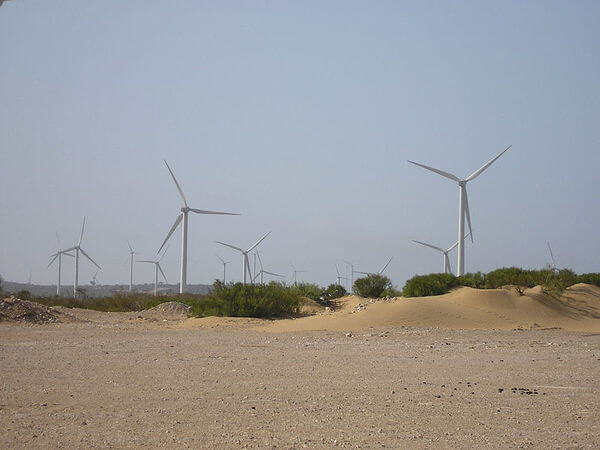News Release from windfair.net
Wind Industry Profile of
'Oriental Nights' powered by Wind and Solar: Arabian World Is Pushing for Renewables
Wind has replaced the 'black gold' as energy source #1 in former oil state Texas. Now more and more countries from the Arab world are following, some of whom have so far made their money mainly with oil. The possibilities to secure their electricity supply by solar and wind energy have become more lucrative than further drilling. At the same time it seems possible to ensure that areas not connected to the infrastructure will be electrified.
The Arab region has a number of pioneers using the alternatives for expensive energy imports from the oil states. Above all, the Kingdom of Morocco in North Africa. The country has set itself ambitious targets with the National Energy Plan: By 2020, 42 and by 2030, even 52 percent of the energy will have to be from renewables. This corresponds to a capacity of 10 gigawatts. The conversion from fossil to renewable energies and thus also increasing energy efficiency is the most important task of current Moroccan policy.
Lately the Moroccan King Mohammed VI. received the 'Energy Efficiency Visionary Award'. In his speech of thanks, he emphasized: "The pressing challenge for our world today is not so much to confront the lack of energy resources as to mobilize the investment needed in this field. It is, therefore, necessary to build the energy infrastructure required and to develope alternative technologies." In addition to huge wind farms and solar power plants mainly installed in the desert regions of the country, solar panels will also be used on private house roofs in the future.
In small Jordan renewables have been booming for the past two to three years. Currently, the country has a capacity of 480 MW of renewables, including 295 MW of solar and 184 MW of wind. The share of renewables is expected to be 10 percent by 2020. Orders over 1,600 MW will be awarded by the end of the year. So far, it was necessary to import expensive oil from Saudi Arabia, which has among other things contributed to the country's chronic trade deficit.
“Countries that have embraced renewable energy have seen the rewards. Investment grows, jobs grow, and there are economy benefits across the board; the Middle East is no exception," says Karl Ove Ingebrigsten, Director of Low Carbon Power Generation Division at Lloyd’s Register.

The Amogdoul wind farm, commissioned in 2007, near Essaouira (image by sqala from Biarritz, France (Eolienne cap sim) [CC BY-SA 2.0, via Wikimedia Commons)
Even 'oil king' Saudi Arabia can no longer ignore the fact that the raw material business is getting worse and worse. For this reason, a comprehensive program for the expansion of renewable energies was launched for the first time in 2013: The aim was to install 54 gigawatts by 2032. But business went slow, as Gulf News reported, and so the Saudi Ministry of Energy itself took over the program.
The new plan: 30 to 50 billion dollars will be invested by the kingdom until 2023 to install a capacity of 10 GW, according to Your Middle East. It remains to be seen whether these ambitious goals can actually be achieved. At the moment there are invitations to tender for 700 MW solar and wind power plants. Many international companies take part such as Acciona, Iberdrola, First Solar, Total and Enel.
The fact that Saudi Arabia is making a step towards renewable energy is not only good for their economy, but also for the world's climate. According to a study by the World Bank, it is currently eighth in terms of CO2 emissions per capita. However, even worse are Qatar, Kuwait and Bahrain. However, these countries are also working to improve their climate: Qatar will begin the construction of their largest solar power plant in June due to be completed by 2020.
And Kuwait even gets US support: At the beginning of May, the National Center for Atmospheric Research (NCAR) announced a new project to be implemented in Kuwait to improve forecast. The results will mainly benefit solar and wind power plants and help the country achieve its target of 15% renewables by 2030. If, for example, sand storms can be predicted more precisely, other power plants can be controlled and regulated more precisely in order to guarantee an even energy supply.
These findings, in turn, also benefit other countries in desert regions, which have focused primarily on solar power plants such as Oman and the United Arab Emirates. The potential is there and the prospects are good that future 'oriental nights' will also be illuminated with renewable energies.
- Author:
- Katrin Radtke
- Email:
- press@windfair.net
- Keywords:
- Arab, renewables, Saudi-Arabia, Jordan, Morocco, Kuwait





